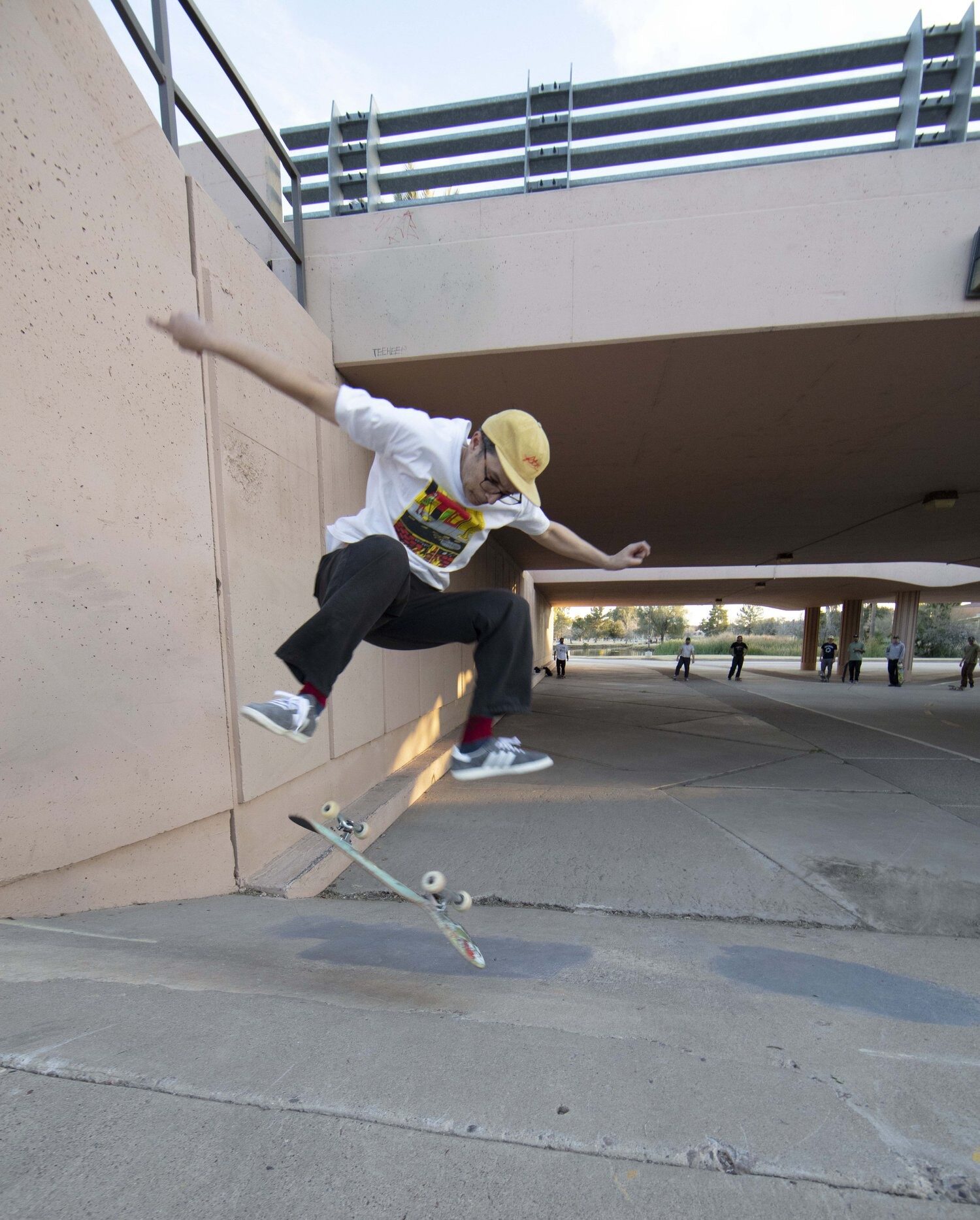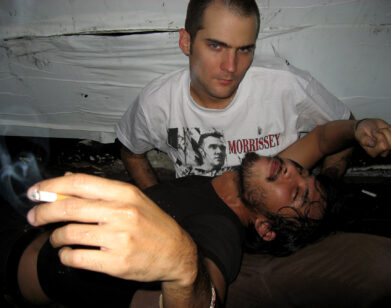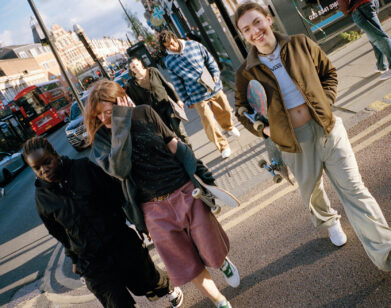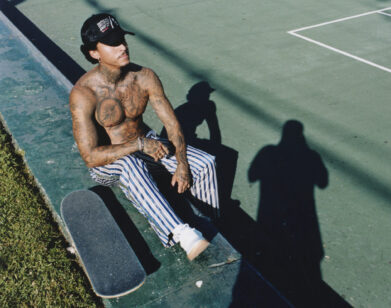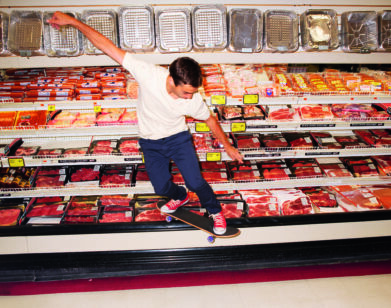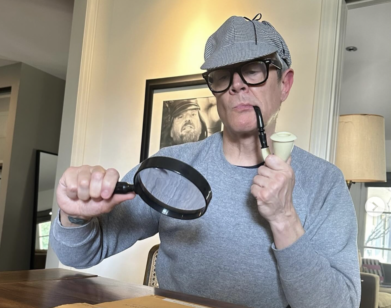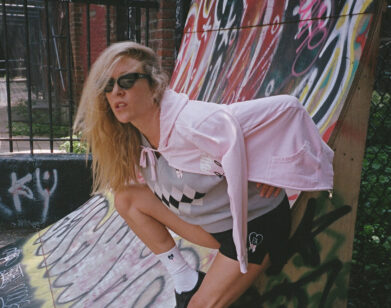SHRED
Literary Skater Boys, Rejoice. José Vadi Wrote a Book For You.
If you open Instagram right now, you’re just as likely to come across nostalgic ’90 skateboarding videos as you are sponsored teen skaters racking up hundreds of thousands of likes. But the sport’s assimilation into mainstream culture is a development that’s gone mostly unexamined, until now. In his new book, Chipped: Writing From a Skateboarder’s Lens, author and essayist José Vadi provides a sort of ethnography-cum-memoir of skateboarding, from his own upbringing in the skate parks of Pomona to the fashion world’s embrace of brands like Thrasher and Supreme. “I think 2023 might’ve been the year of the model skateboarder,” Vadi told us last month. “In the Venn diagram of subcultures that become more mainstream, skateboarding overlaps with hip-hop so much that it’s not surprising that a Virgil [Abloh] begets another person that curates a whole skater-inclusive vibe.” In conversation with Interview social editor Julian Ribeiro, Vadi talked to us about the Reelsification of skateboarding and why shredding under an abandoned freeway will always trump a swanky skate park.
———
JULIAN RIBEIRO: Hey, José.
JOSÉ VADI: How are you?
RIBEIRO: Good, I’m glad to be here. It was really cool to read a book about skating and its culture. I feel like every time you’re consuming skating, it’s an Instagram Reel of an old YouTube video. The written word is probably the least-used medium for interacting with skating. What was it like to bring that into a book?
VADI: You hit a really good point, which is, a lot of people bought Thrasher for the photos and not the writing, you know what I mean? And it’s kind of funny how much of skateboarding history is told through advertisements that present new skaters and new tricks.
RIBEIRO: 100 percent.
VADI: So it’s interesting that the digitization of that is now Instagram Reels and the copy is still super minimalistic, just bunch of fire emojis and maybe a devil horns emoji. And the element of surprise of watching a new skate video sometimes gets lost when the greatest parts get shared through an Instagram Reel. So much of watching a skate part is feeling that inertia of the skateboarding, the music, the editing, the cinematography, the fits. Everything’s coming together at once. So to your question, creating movement in the essays and articulating it on the page was one of the challenges.
RIBEIRO: The Instagram Reelsification of skate parts is like only hearing singles versus hearing an album. I feel like Stay Gold was more inspiring than like, “Yeah, I saw one really banger clip on Instagram Reels and now I’m excited to go skating.”
VADI: Or falls. A lot of folks that don’t skate will talk to skaters and be like, “I saw this one fall on my Discover page.”
RIBEIRO: Yeah. It’s funny that a lot of people outside of it would say the most impressive part is falling and getting up. When I was reading it, too, I was thinking about contemporary skateboarding culture. For a little context, my father is Brazilian and moved here in his early 20s. He had been skating since he was a child and skated up until his 40s, and the way he interacts with it is so different from skateboarding with other people in my age group. When he talks about it he’s like, “This is the roughest, rawest. We were the dirtiest fucking people ever.” And I hate to be like, “It’s so much more mainstream,” but because it’s more visible, the idea of the skater as a truly dirty punk isn’t as prevalent. I think the rebellious image has changed over time.
VADI: Definitely. And the Brazilian scene, they make their own products, they have their own publications. The flip side of that is that we’re also recognizing more and more of this relationship between fashion and skateboarding. I think 2023 might’ve been the year of the model skateboarder. I mean, so many skateboarders were walking down the catwalk. And more power to them. A lot of skaters have agency representation now. It’s like, is that a product of skaters having more self-worth around how they look at themselves within skateboarding and beyond? It might be a confluence of all these things. In the Venn diagram of subcultures that become more mainstream, skateboarding overlaps with hip hop so much that it’s not surprising that a Virgil [Abloh] begets another person that curates a whole skater-inclusive vibe. Much like when Menace started in the early ’90s, they saw themselves as the next Mobb Deep. You know?
RIBEIRO: Yeah.
VADI: And we’re even seeing that in other ways like mental health, sexual violence prevention, a lot of these conversations and initiatives are happening in skateboarding.
RIBEIRO: I was joking with someone a few days ago about how we see all these people getting free shoes and posting them like, “Thank you, Vans. #Ad.” The #Ad era of skateboarding for social media is real. There’s a social currency to being a hot young guy who’s good at skateboarding. But damn, seeing Ben Kadow skate in skinny jeans with slip-on Vans in 2024 makes me be like, “Yeah, slip-on Vans are kind of cool.” My brain also harkens to the high-fashion skate shoe, the Lanvin low-top.
VADI: Oh, yeah.
RIBEIRO: They’re literally Osiris D3s with fat laces. And it was Future and Offset and all these people in those shoes. The skate shoe meta is always so interesting. During COVID, I feel like Half Cabs and Dunks were the hottest shoe.
VADI: Yeah, we’re seeing a lot of different trends out there, and they’re always changing. The thing that you lined up for at Supreme a year ago is now something that you’re talking shit about on the Slap message board. And that’s kind of fine. You know what I mean? Skateboarding itself changes so quickly and so rapidly. It’s crazy to think that we’re 10 years-plus deep in a post-FA/Hockey society.
RIBEIRO: Wow. Yeah.
VADI: You can track those moments and those impacts. When Tony Hawk landed the 900 in 1999, what was so interesting was all the deals he was making. Initially, he was going to the parents and the little kids, hence Hot Wheels and Hot Pockets. It’s interesting to see how figures like that changed with the digital times, so now he has a podcast.
RIBEIRO: I’m also from a generation that attended demos and stuff. Now, kids aren’t like, “I fuck with this team,” the same way that they might’ve done 20 years ago. It’s more on an individual basis. Marketing skateboarders as athletes changed things. Like, Travis Kelce is an ad for—what team is he on?
JOSE VADI: The Kansas City Chiefs?
JULIAN RIBEIRO: Yeah. Travis Kelce is an ad for Travis Kelce, but he’s also an ad for the Chiefs. And skateboarding now works the way that sports sponsorships works like, Nyjah Huston can’t get on a skateboard if he’s not wearing a Monster logo. That’s still a traditional sports world way of advertising. I could foresee a world where, as skating gets bigger and even more money comes in, brands are like, “Hey, bud, you’ve got to wear the box logo if you get on that thing.”
VADI: Oh, yeah. You’re seeing a little bit of that in the Olympics. It’s just part of the game now. And like any athlete, they only have so many years.
RIBEIRO: Is this the second Olympics with skateboarding?
VADI: You’re correct. Yeah.
RIBEIRO: Yeah, it almost brings up a question of how that translates when you’re on a stage a thousand miles away. If Tyshawn Jones ollies over the train platform, it’s sick because he’s the ultimate New York guy and you’re downtown. So much of skateboarding comes from the context that surrounds it.
VADI: Totally. But it speaks to the difference between street skateboarding and competitive skateboarding. There was a cool moment, I think in the last Olympic Games in Japan, where the female bowl skaters had this kind of hug-it-out moment after someone fell on the last run. You see those traditional athletic sportsmanship moments in competitive skateboarding. But even saying sportsmanship is so weird. That’s such a Little League, athletic childhood kind of term.
RIBEIRO: Right.
VADI: I mean, to your dad’s generation or to the Duane Peters of the world, that’s antithetical to skateboarding. But the beauty of this culture is that you can agree or disagree with things, and that’s why the subtitle of my book is “Writing from a Skateboarder’s Lens.”
RIBEIRO: Yeah.
VADI: The skate park closest to my house is a slab park surrounded by grass with no transitions, so you just run on your board and hit ledges. It’s fine, it’s great. It’s a great little laboratory to learn tricks. But I was debating going there or the slappy spot next to the refinery underneath the freeway by the river here in Sacramento, and I was just reminded of my friend saying, “Between a skate park and a street spot, I’ll always choose a street spot.” He’s like, “You could pave the world, but I’m always going to go to the street as opposed to a spot that is telling you how to skate.” As more skate parks get built, it’s interesting to see them become these hybrid spaces where it’s part of a public plaza with pedestrians, like what I imagine Tompkins is. I think that public space is a little bit better than like, “Here’s a 20-stair hubba, go get the gold medal.”
RIBEIRO: Yeah. It’s another interesting aspect of social media in skateboarding. People have warmed up to seeing people skateboarding in public areas.
VADI: Yeah. Hollywood High too, you see that in the Reynolds bigger three. There’s that trick of Miles Silvas doing a switch flip in New York recently, and there was a big crowd there. It was probably somewhere in Midtown. When you’re coexisting like that, it’s really rad to see. I always think about the skit in the Girl Skateboards video, “Mouse,” where Rick Howard is wearing the mouse costume and interacting with the public as both skateboarder and a human-sized mouse. Your relationship with public space and the built environment can go in all sorts of ways, and skateboarding is a great vehicle to explore that.
RIBEIRO: Another thing that the book does really well is illustrate the community that’s created when you’re skateboarding with other people. And that’s shifted, too. I almost feel like you see groups of people who are matched together by Instagram and it’s like, “Do these guys actually know each other or do the three coolest guys in every city link up in Paris to wear a Supreme hoodie?”
VADI: I’ve had those similar questions, too. But if you look at companies like Palace, they’ve stayed true to who they are in London. And more and more, you’re seeing companies centered around crews, like Carpet coming out of the East Coast.
RIBEIRO: Yeah.
VADI: It’s absolutely amazing what they’re doing. The crew is, I think, shaping skateboard companies and cultures again. And that’s really cool. I think the homie edit is as valuable as the high-end fly-around-the-world edit, and what still makes skateboarding so exciting and so palpable and attainable for skaters themselves. It makes us continuously want more.

